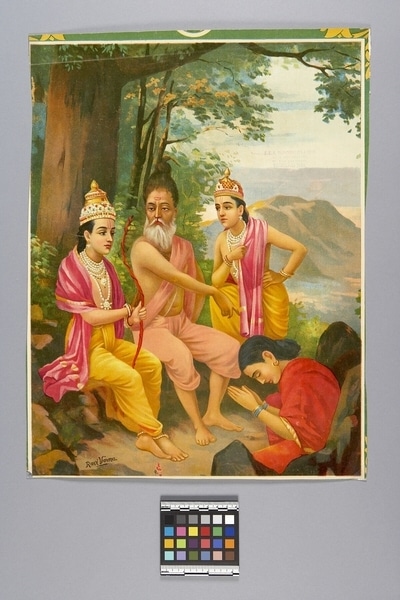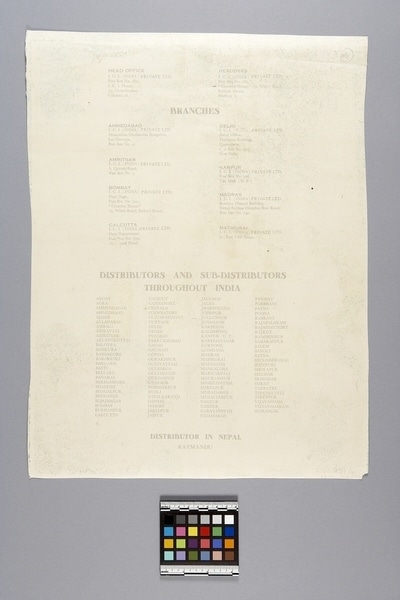Calendar Item Number: Eg237 from the MOA: University of British Columbia


Description
Rectangular shaped calendar print. Depicted are three males with Rama in the middle and Sita kneeling with her head bent and hands held in worship. All are talking under a brown tree with a large trunk, foliage and mountains in background. Rama has white beard, brown hair in top knot, wearing a pink cloth wrap from waist; points towards left with his right arm, while looking at male on his right. Young males are wearing yellow cloth garments with pink cloth wrapped around their shoulders; white pearls and gold caps. Male on left grasps red bow like object. Print has unevenly cut edges. Back is covered with grey printed text. Brown signature on bottom left reads: Ravi Varma.
History Of Use
Indian popular religious prints have been published for nearly a century, first by German presses, later by Indian ones. The prints may take the form of calendars, posters, or simply images. The style of the representations is European. In the beginning they were Hindu images, but are now acquiring elements both of folk art and a romantic secularism. It is a living art currently influenced by the movie industry and non-Hindu religions. The images are a vehicle for advertising and are also used for religious purposes.
Cultural Context
calendar art; popular religious art
Narrative
Rama, the most perfect of princes, and his noble wife Sita portray the ideal couple by their acts of self-denial for the good of society. Popular episode is Rama's rescue of Sita from the ten-headed demon king, Ravana, with the help of Hanuman and Lakshmana.
Iconographic Meaning
Rama, seventh incarnation of Vishnu, is identified by the presence of his ideal, loving wife, Sita, by his side; Vaishnavite 'u' on forehead; bow and arrow-filled quiver symbolizing masculine virtures; green-coloured skin; either dressed as a king or forest dweller; presence of Hanuman, half-human, half-monkey deity, often shown kneeling at Rama's feet; and presence of Rama's brother Lakshmana, also carrying an arrow-filled quiver.
Item History
- Made by Ravi Varma (Maker) in India during 1950
- Collected between 1974 and 1982
- Owned by Stephen Inglis before January 1983
- Received from Stephen Inglis (Donor) during January 1983
What
- Name
- Calendar
- Identification Number
- Eg237
- Type of Item
- calendar
- Overall
- height 47.3 cm, width 36.0 cm
Who
- Culture
- South India
- Creator
- Ravi Varma (Maker)
- Previous Owner
- Stephen Inglis
- Received from
- Stephen Inglis (Donor)
Where
- Holding Institution
- MOA: University of British Columbia
- Made in
- India
When
- Creation Date
- during 1950
- Collection Date
- between 1974 and 1982
- Ownership Date
- before January 1983
- Acquisition Date
- during January 1983
Other
- Item Classes
- works on paper
- Condition
- good
- Accession Number
- 0857/0092